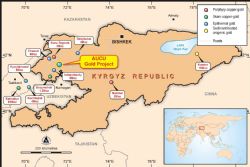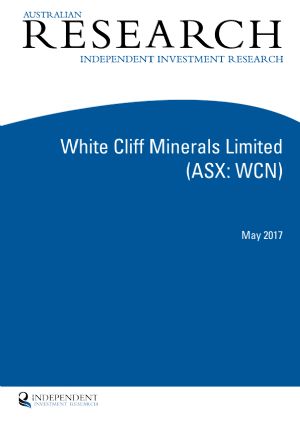
Alluvial Bulk Sampling Assay Results
Perth, Mar 14, 2019 AEST (ABN Newswire) - White Cliff Minerals Limited ( ASX:WCN) ("White Cliff" or the "Company") is pleased to report gold assays for the bulk samples collected in December 2018.
ASX:WCN) ("White Cliff" or the "Company") is pleased to report gold assays for the bulk samples collected in December 2018.
Highlights
- Alluvial bulk sample assays reveal gold concentrations up to 104 mg/t (on a wet basis)
- Visible gold identified in 62 of 65 concentrate samples panned from alluvial bulk samples
In December 2018 the Company undertook a bulk sampling program along a 450 metre section of the Chanach river alluvial terraces 1 kilometre downstream from the Aucu Gold deposit to assess the placer gold potential of the 16km long river system (see Figure 1 in link below).
The samples were washed screened and pan concentrated from 30-60 kilogram wet gravel samples down to approximately 30-60 grams of concentrate. Visible gold was detected in 62 samples out of the 65 samples collected as reported in the ASX release dated 15 January 2019.
The laboratory assays revealed gold concentrations in the bulk samples ranging from 0.35 mg/t (wet) to 104 mg/t (wet). Grades above 50 mg/t (dry) are considered to be potentially economic. The Company cannot report results on a dry basis due to the sampling method employed where the samples were initially weighed while containing moisture. Further, alluvial gold results are normally reported in milligrams per cubic metre (mg/m3) which cannot be reported as density and moisture analysis has not been conducted.
The bulk sampling was conducted from surface to a depth of 5 metres in an area where the alluvial gravels are approximately 12-15 metres deep. Alluvial gold generally deposits in areas where high energy water flow slows down and the gold is deposited in sinuous zones called leads on the inside curve of bends in the river. Over time the gold gradually works its way to the base of the alluvial channel. The presence of gold in the upper 5 metres of the river channel is encouraging as it indicates an active gold deposition system where gold grade generally increase with depth. The alluvial river gravels extend for 16 kilometres within the lease and gravel depths range from 5 metres near the start of the river on the eastern end of the lease to 15-20 metres near the western end of the lease. Alluvial mining has been conducted for 4 years by a neighbouring tenement holder to a depth of 15 metres right up to the Aucu lease boundary suggesting that gold grades increase with depth and may be high enough to be economic.
The Company considers the initial results very encouraging and plans to conduct further bulk sampling using a more detailed sampling method suitable for defining mineable resources. This will entail density and moisture analysis.
Bulk Sampling Procedure
The bulk sampling was conducted using an excavator in preference to using drilling as it was more cost effective and provided a must larger sample that is statistically more representative of the gold distribution in the gravels.
Sampling was conducted 1km west of the Aucu gold deposit and covered an area 450 metres long and 90 metres wide (see Figure 1 in link below). A Hyundai 30 tonne excavator completed 65 bulk samples consisting of 13 holes 5 metres depth extracting approximately 35 cubic metres from each hole.
Each metre in depth was sampled separately and assessed for alluvial gold, rock and clay particle size distribution. 30- 60 kilogram sub-samples were collected and manually panned down to a concentrate.
The concentrates consist of heavy minerals including magnetite, iron sulphides, trace copper and gold. Gold occurs as discrete grains ranging from specks up to 2mm. The gold is generally sub angular indicating that it is close to the original hard rock source.
Assessment of the gold distribution highlighted a trend where the size of the gold particles decreased but gold particle abundance increased as the sampling moved westwards down the river. This is a common feature of alluvial gold deposits where the coarse (heavy) particles deposit first as the water slows down. Smaller and lighter gold particles are transported until as the water slows further and they also deposit on the river bed.
Current Exploration
The Company expects to re-commence exploration activity in March with initial work on cleaning the access road to the main drilling locations and camp area allowing field visits by parties interested in purchasing the project.
Project Background: Aucu Gold Deposit
The Aucu gold deposit currently contains an Inferred Gold Mineral Resource above a cut-off grade of 1 g/t gold of 2.95 Million tonnes grading 5.1 g/t gold for 484,000 ounces of contained gold. The new resource reported in May 2018 represented a 60% increase in contained gold over the previously reported April 2017 inferred gold resource.
The project also contains an Inferred Copper Mineral Resource of 17.2Mt at 0.36% copper containing 64,000 tonnes of copper.
The drilling defining these resources has tested less than 5% of the identified mineralised structures and is currently open in all directions. The exploration carried out in this announcement has identified substantial additional potential over a large area on the eastern side of the project with rock chip samples of outcropping shear zones, veins and skarn alteration carrying gold grades of up to 6.7 g/t gold and 7.8% copper. As yet, no exploration has been conducted to the south or to the west of the main porphyry system.
In addition to the hard rock potential, the Company has identified visible gold in the alluvial river gravels that extend 16 kilometres from west to east across the Aucu project area.
To view tables and figures, please visit:
http://abnnewswire.net/lnk/W6J0L1ZV
Contact
Todd Hibberd
Technical Director
T: +61-8-9321-2233
E: info@wcminerals.com.au
W: www.wcminerals.com.au
| ||
|










